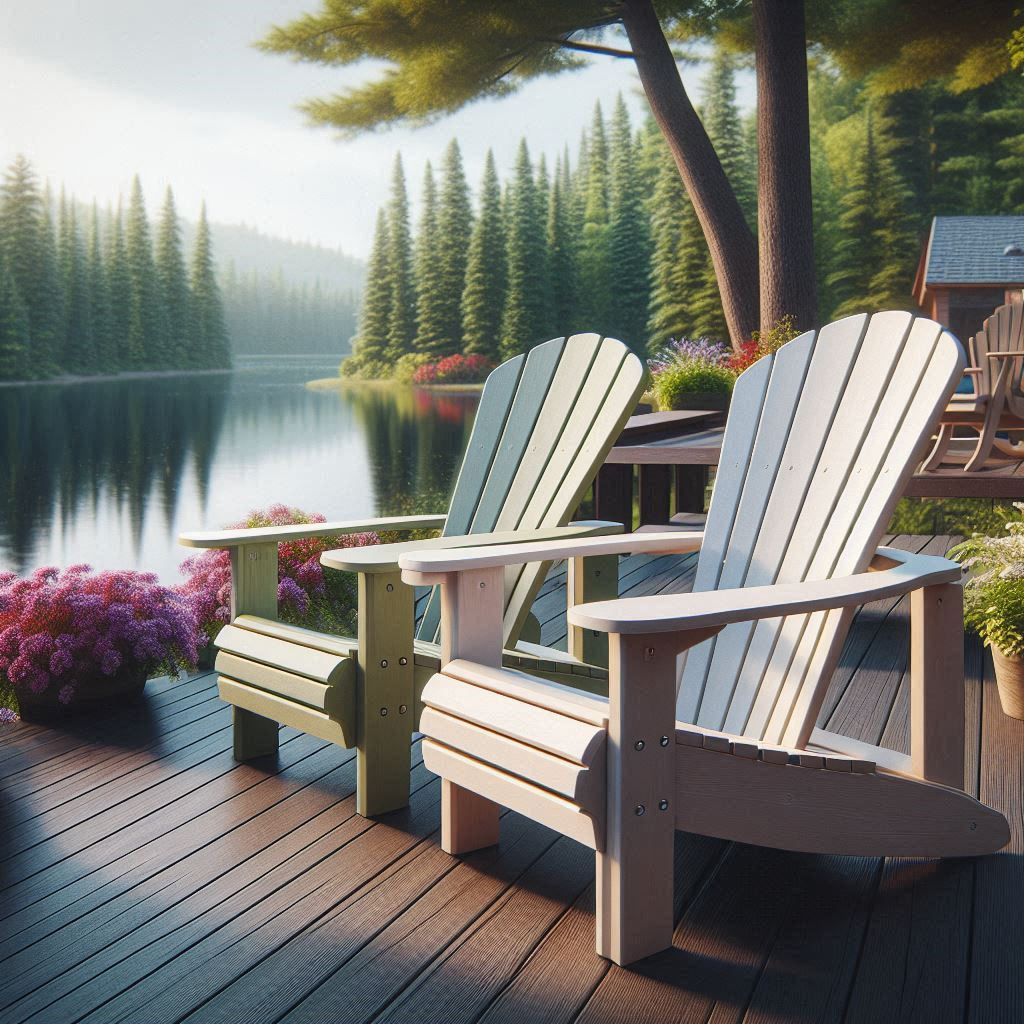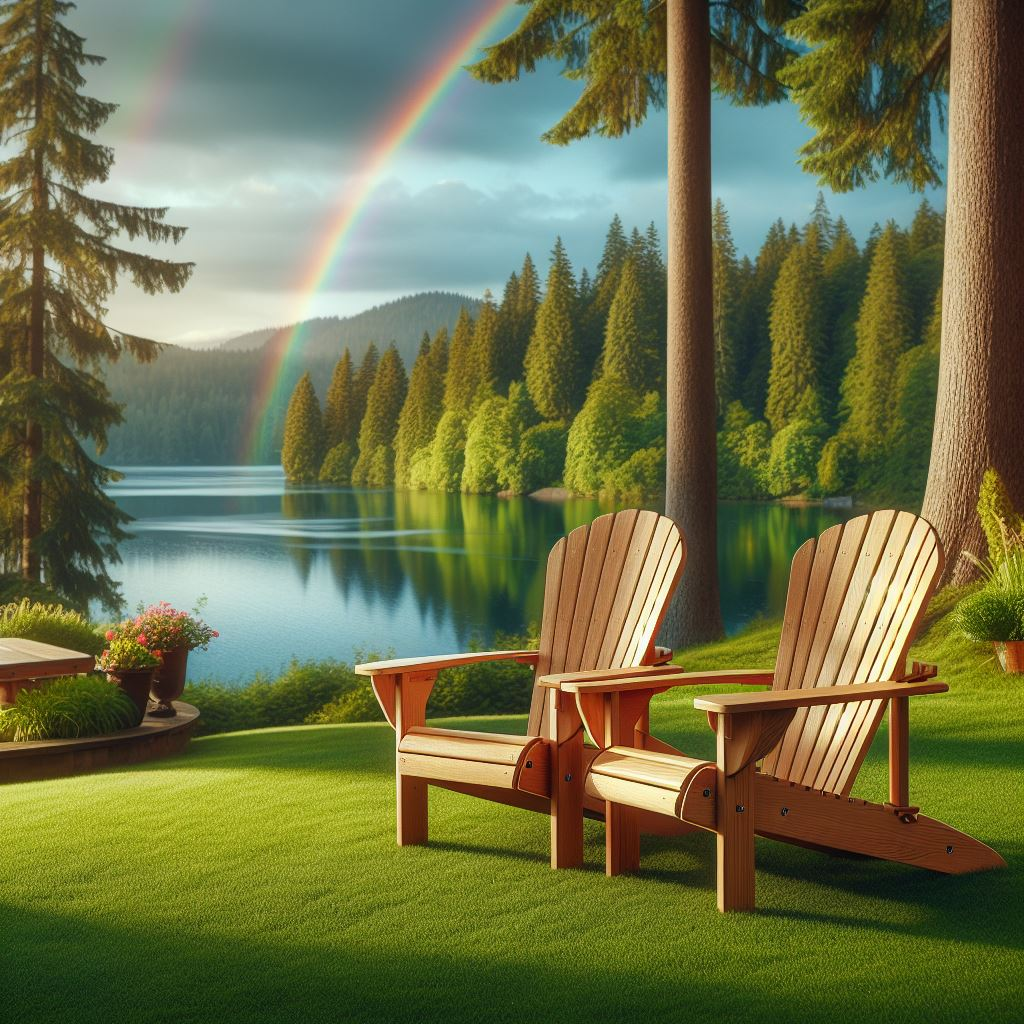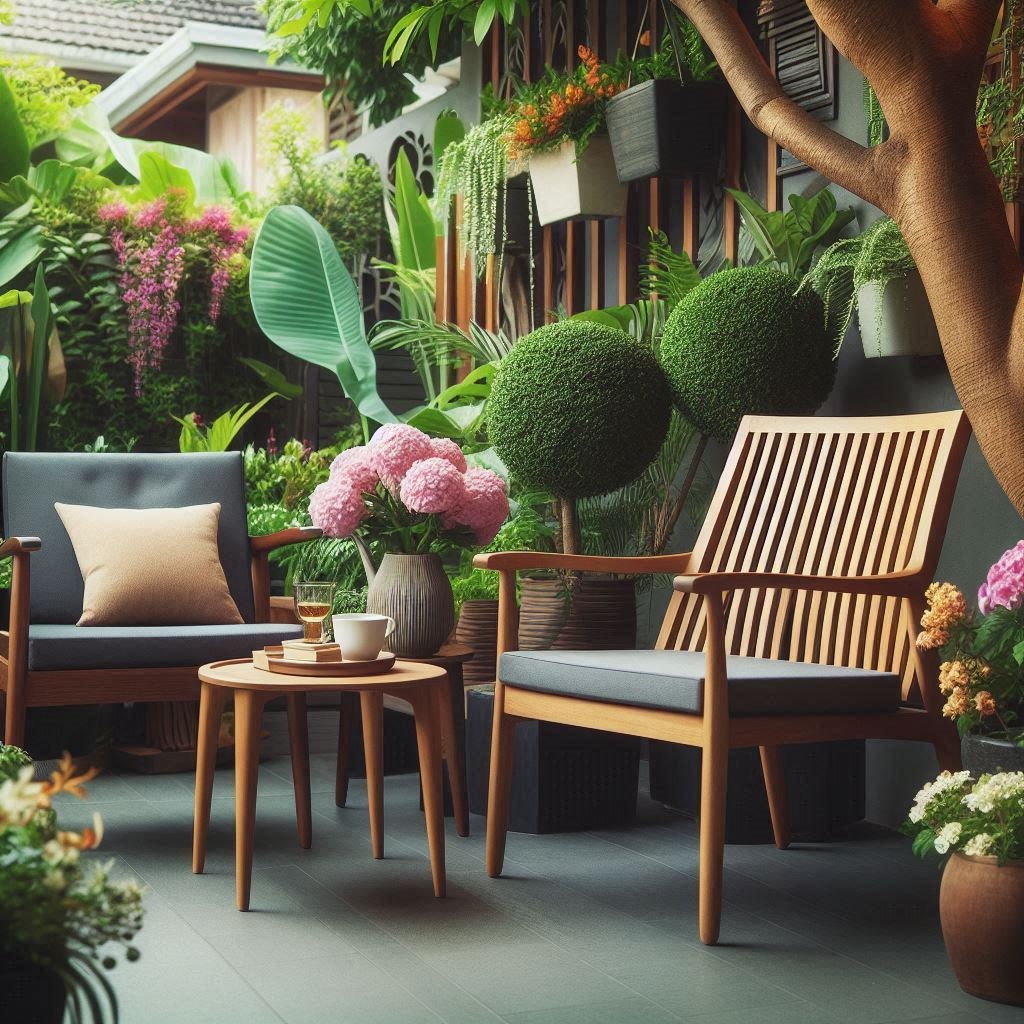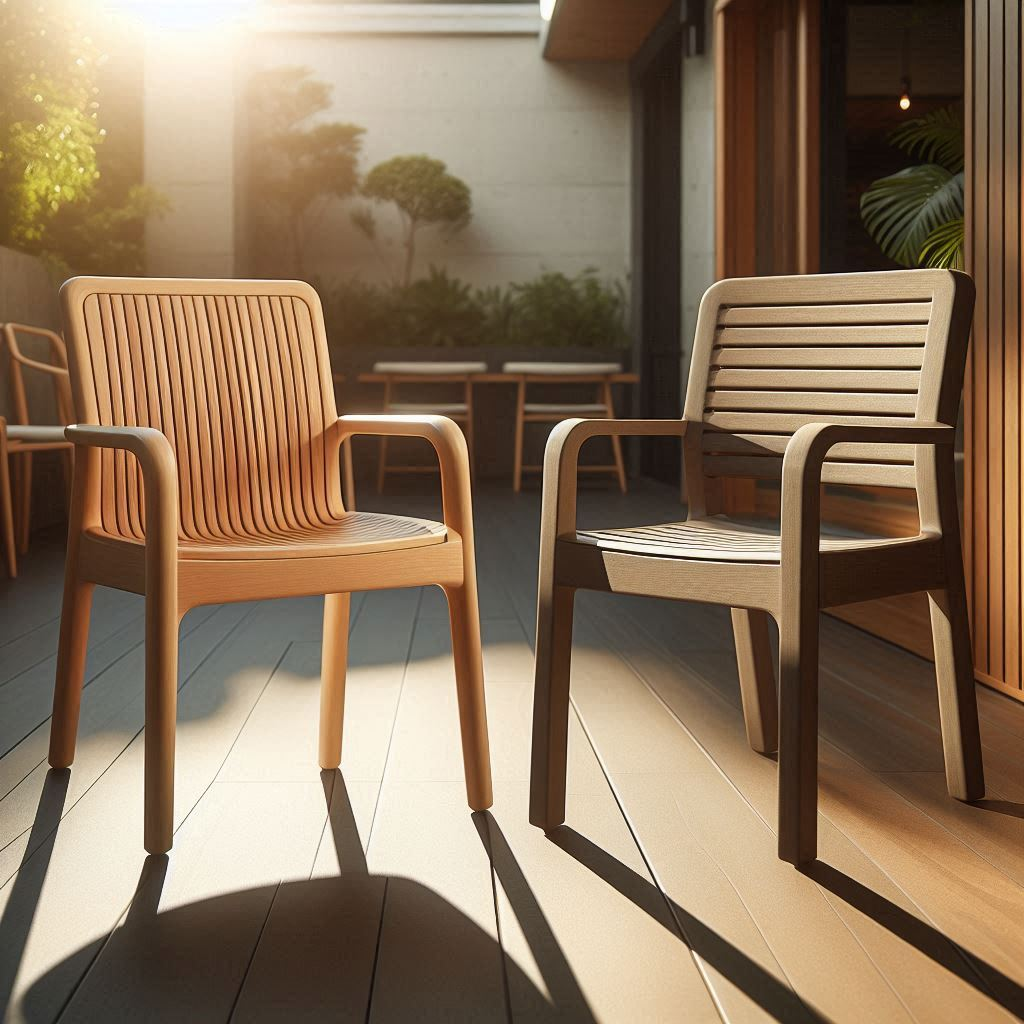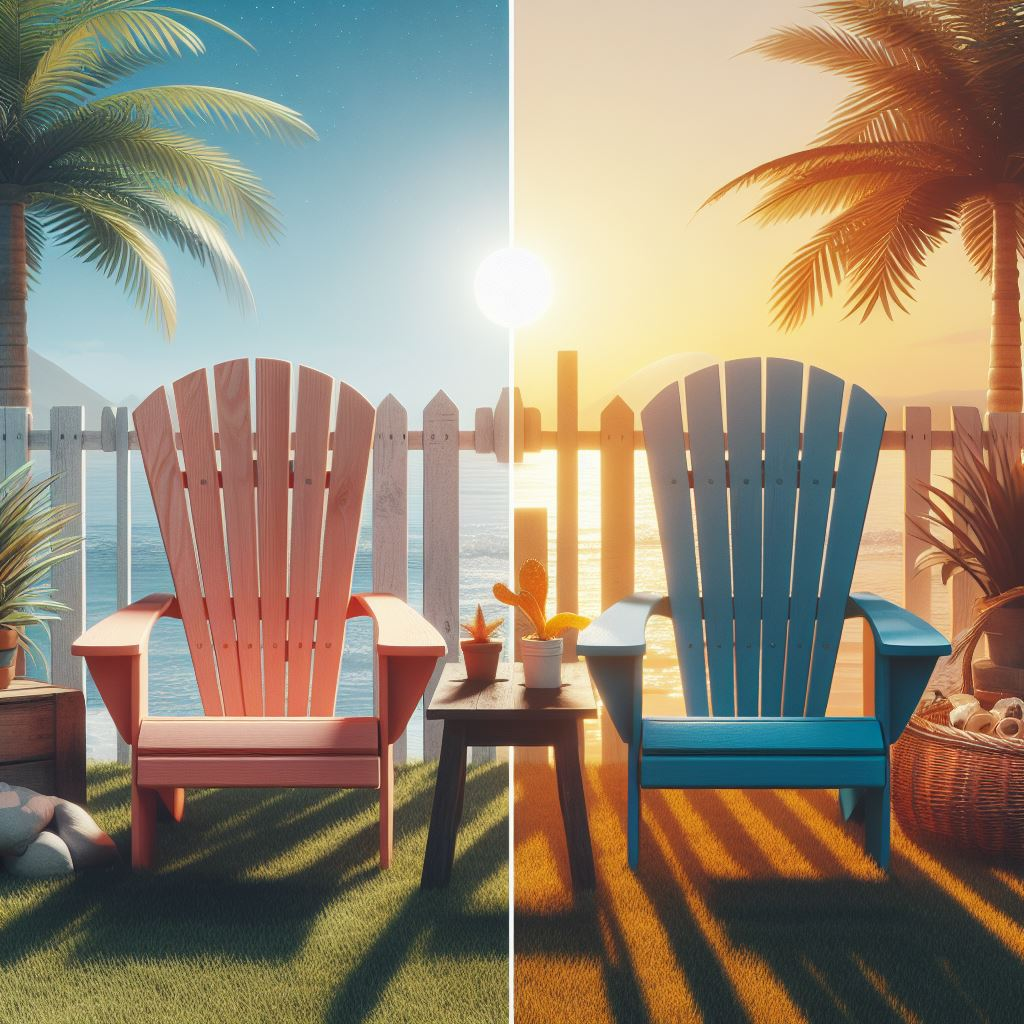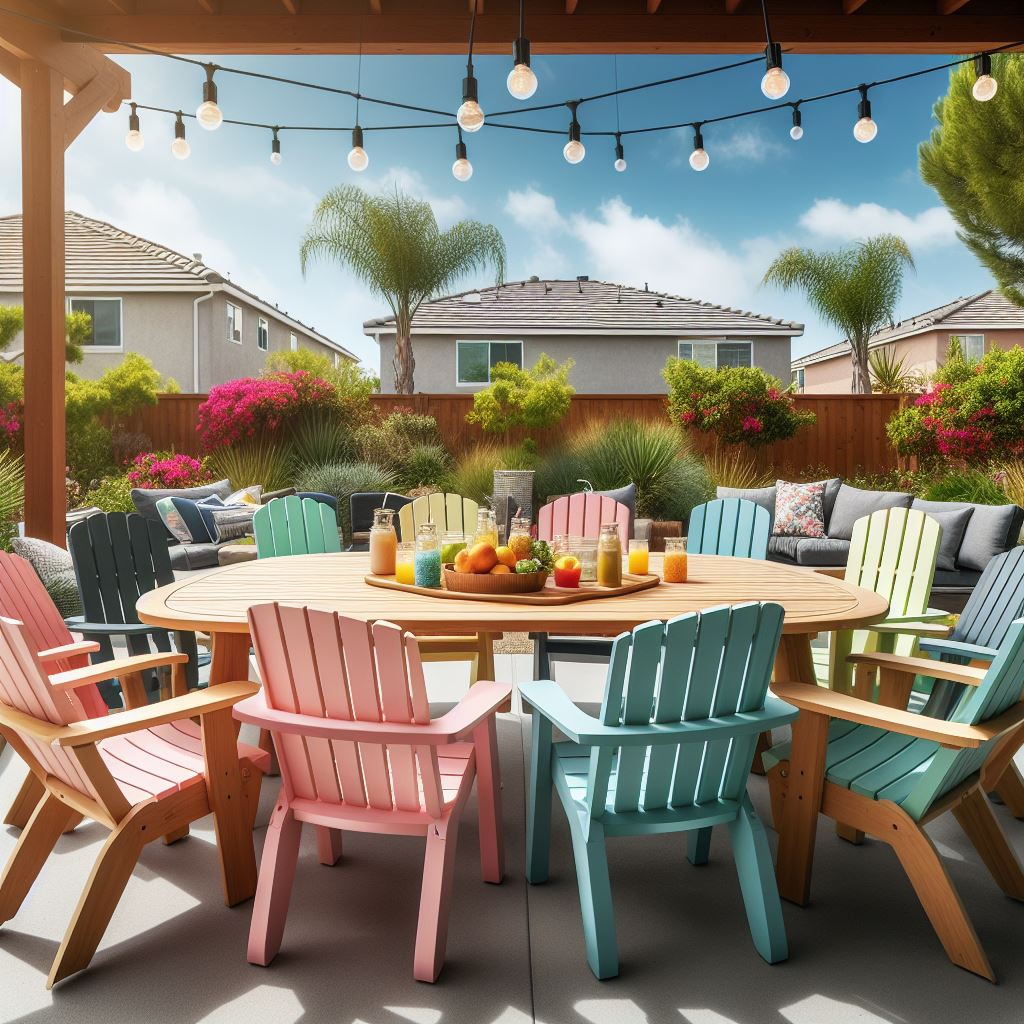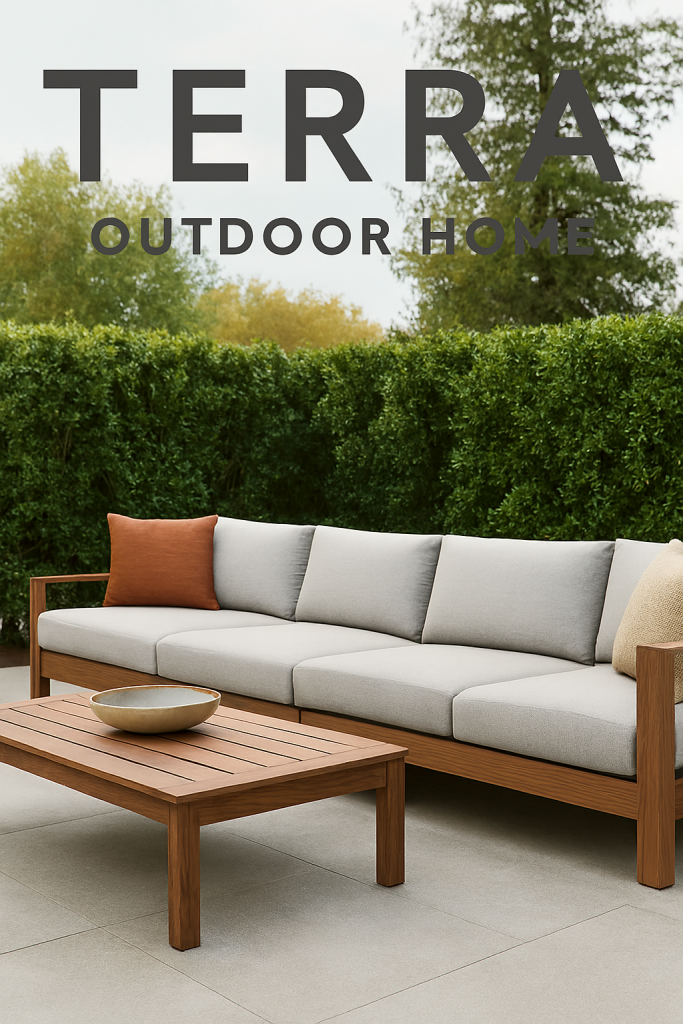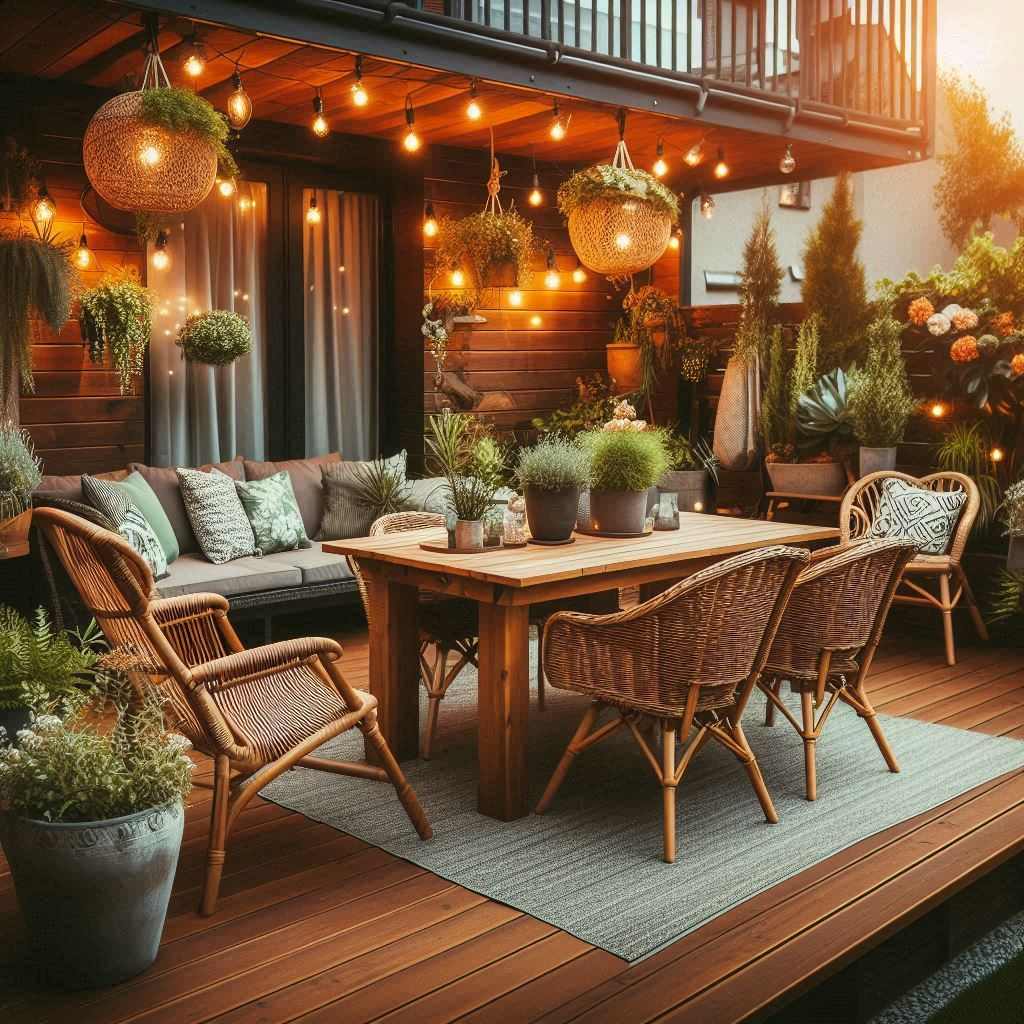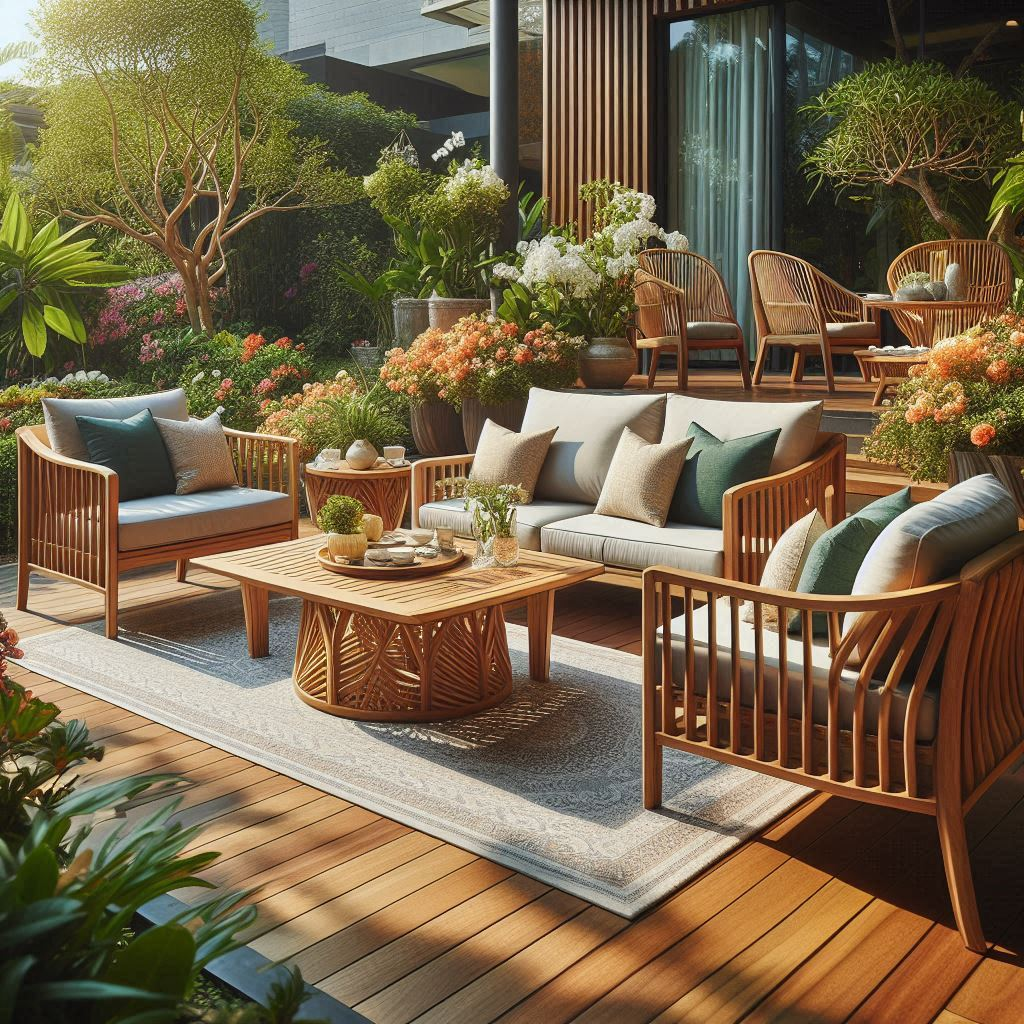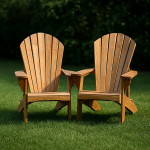Last summer, I watched my neighbor’s $3,000 teak dining set slowly turn gray while my five-year-old Polywood chairs looked exactly the same as the day I bought them. That moment sparked a deep dive into understanding what really makes outdoor furniture worth your money – and the results might surprise you.
After spending months researching, interviewing manufacturers, and analyzing real homeowner experiences, I’ve discovered that the choice between Polywood and hardwood isn’t as straightforward as most furniture salespeople would have you believe. The truth involves complex mathematics, hidden costs, and surprising environmental considerations that could save you thousands of dollars over the next decade.
What You’re Really Buying: The Material Science Behind Your Investment
When you purchase outdoor furniture, you’re not just buying a chair or table – you’re investing in a molecular structure that will either withstand or surrender to nature’s relentless assault. Understanding this difference is crucial because it affects everything from your annual maintenance budget to your home’s resale value.
Polywood represents a engineered solution: recycled plastic lumber manufactured from high-density polyethylene (HDPE). This material contains integrated UV inhibitors that lock in color at the molecular level. UV inhibitor compounds are fully integrated into the lumber, locking in lasting color and fade resistance, which means the color goes all the way through the material rather than being applied as a surface treatment.
Traditional hardwoods like teak, cedar, and eucalyptus rely on natural cellular structures and oils for weather resistance. Top-quality teak furniture can easily endure 30-50+ years outdoors and with regular maintenance can last anywhere from 50 to 100 years or even longer. However, this longevity comes with significant ongoing investment requirements.
The Real Cost Analysis: What Your Spreadsheet Should Actually Show
Here’s where most furniture comparisons fail – they only look at upfront costs. The true financial picture requires analyzing total cost of ownership over realistic timeframes, including maintenance, replacement parts, and opportunity costs.
Initial Investment Breakdown
| Material Type | Entry Level | Mid-Range | Premium |
|---|---|---|---|
| Polywood | $800-1,200 | $1,500-2,500 | $3,000-4,500 |
| Cedar | $600-1,000 | $1,200-2,000 | $2,500-4,000 |
| Teak | $2,000-3,500 | $4,000-7,000 | $8,000-15,000+ |
| Eucalyptus | $800-1,500 | $1,500-2,800 | $3,500-6,000 |
Note: Prices based on complete 6-piece dining sets from major retailers as of 2024-2025
Annual Maintenance Requirements and Costs
The hidden expenses start appearing in year two. Hardwood furniture demands regular maintenance that most homeowners drastically underestimate.
Polywood Annual Maintenance:
- Time required: 2-3 hours per year
- Materials cost: $15-25 (soap, water, occasional deck brush replacement)
- Professional service: Not required
- Annual total: $25 maximum
Cedar Annual Maintenance:
- Time required: 8-12 hours per year
- Materials cost: $80-150 (sealers, stains, sandpaper, brushes)
- Professional service: $200-400 every 2-3 years
- Annual total: $180-250
Teak Annual Maintenance:
- Time required: 6-10 hours per year
- Materials cost: $120-200 (teak oil, cleaners, fine sandpaper)
- Professional service: $300-600 every 2-3 years
- Annual total: $220-350
The 10-Year Total Cost of Ownership
Running these numbers through a decade reveals the true financial picture:
Polywood 10-Year Cost:
- Initial investment: $2,000 (mid-range set)
- Maintenance: $250
- Replacement parts: $0 (20-year warranty)
- Total: $2,250
Cedar 10-Year Cost:
- Initial investment: $1,600
- Maintenance: $2,000
- Replacement/refinishing: $800
- Total: $4,400
Teak 10-Year Cost:
- Initial investment: $5,500
- Maintenance: $2,800
- Professional restoration: $1,200
- Total: $9,500
The mathematics reveal that Polywood provides the lowest total cost of ownership, despite potentially higher upfront costs in some categories.
Durability: The Science of Survival
Weather resistance isn’t just marketing speak – it’s applied materials science. Each material handles environmental stress through different mechanisms, with dramatically different results.
How Polywood Handles Weather Extremes
Made from high-density polyethylene, it resists fading, splintering, and cracking because plastic doesn’t have grain structure that can separate or cellular structure that can absorb moisture. Because it is plastic, it does not attract pests like termites or rodents and does not absorb moisture.
The engineering advantage is significant: furniture is built to withstand all four seasons, including extreme climates like hot sun, heavy snow, salt spray, and strong winds. This isn’t theoretical – it’s backed by a 20-year warranty on lumber.
Hardwood Weather Response Patterns
Natural wood responds to environmental conditions through expansion, contraction, and cellular breakdown. Teak is renowned for its longevity and ability to survive exposure to the elements with very little maintenance, but “very little” is relative to other woods, not to synthetic alternatives.
Teak wood lasts between 75 and 100 years outside, even longer when properly maintained, which represents exceptional durability. However, this longevity requires consistent care and comes with the understanding that the wood will change color, develop cracks, and require periodic restoration.
Cedar shows different characteristics: Cedar outdoor furniture will still last many years but will require more upkeep compared to teak, with typical lifespans of 15-25 years depending on climate and maintenance.
Performance Comparison Across Critical Factors
Weather Resistance Testing
Independent testing reveals how materials perform under standardized conditions:
| Material | UV Resistance | Moisture Absorption | Temperature Cycling | Salt Spray Resistance |
|---|---|---|---|---|
| Polywood | Excellent (integrated UV inhibitors) | None (0% absorption) | Excellent | Excellent |
| Teak | Good (natural oils) | Low (8-12%) | Good | Excellent |
| Cedar | Fair (requires treatment) | Moderate (12-18%) | Fair | Good |
| Eucalyptus | Poor without treatment | High (15-25%) | Poor | Fair |
Maintenance Requirements by Climate Zone
Humid Subtropical (Southeast US):
- Polywood: Annual washing only
- Teak: Bi-annual cleaning, annual oiling
- Cedar: Quarterly inspection, bi-annual treatment
- Eucalyptus: Monthly inspection, seasonal treatment
Arid Desert (Southwest US):
- Polywood: Annual washing, no UV protection needed
- Teak: Annual cleaning, bi-annual oiling
- Cedar: Annual sealing, quarterly inspection
- Eucalyptus: Monthly oiling, frequent sealing
Coastal Regions (Any US Coast):
- Polywood: Monthly saltwater rinse, annual deep clean
- Teak: Monthly cleaning, bi-annual maintenance
- Cedar: Bi-weekly inspection, monthly treatment
- Eucalyptus: Weekly cleaning, monthly sealing
The Aesthetic Evolution: How Your Furniture Will Look Over Time
Understanding how materials age helps set realistic expectations and influences maintenance decisions.
Polywood Aging Pattern
Year 1-5: Maintains original color and texture Year 6-15: Minimal color variation, surface remains smooth Year 16-20: Slight color mellowing, structure remains solid Year 20+: Color may show subtle changes, but functionality preserved
Teak Aging Pattern
Year 1: Rich golden-brown color Year 2-3: Color begins silvering if untreated Year 4-10: Full silver-gray patina develops (considered desirable by many) Year 10+: Structural integrity remains excellent with proper care
Cedar Aging Pattern
Year 1-2: Natural red-brown color with aromatic properties Year 3-5: Color fades to gray without treatment Year 6-10: Potential for splitting and checking Year 10+: Significant degradation without consistent maintenance
Environmental Impact: The Sustainability Calculation
Modern consumers increasingly consider environmental factors in purchasing decisions. The sustainability comparison involves manufacturing processes, transportation, longevity, and end-of-life disposal.
Carbon Footprint Analysis
Polywood Manufacturing:
- Raw material: 90% recycled content (primarily milk jugs and detergent bottles)
- Energy consumption: High during initial processing
- Transportation: Typically manufactured domestically, reducing shipping emissions
- Longevity factor: 20+ year lifespan reduces replacement frequency
Hardwood Harvesting and Processing:
- Teak: Often harvested from managed plantations (positive) but frequently imported (negative)
- Cedar: Typically North American sourced (positive for transportation)
- Processing: Lower energy requirements than plastic manufacturing
- Longevity factor: Can exceed Polywood lifespan with proper care
Recycling and End-of-Life Considerations
Polywood can be recycled again at the end of its useful life, theoretically creating a closed-loop system. However, the infrastructure for recycling composite lumber isn’t universally available.
Hardwood furniture can be repurposed, burned for energy, or composted, making it completely biodegradable. However, chemical treatments used in maintenance may affect disposal options.
Installation and Setup: The First Impression Factors
Your furniture’s performance starts with proper installation, and different materials have varying requirements that affect both immediate satisfaction and long-term durability.
Assembly Complexity and Hardware Considerations
Polywood Assembly:
- Hardware: Stainless steel fasteners resist corrosion
- Tools required: Standard drill and basic hand tools
- Time investment: 2-4 hours for complete dining set
- Special considerations: Pre-drilled holes prevent cracking
Hardwood Assembly:
- Hardware: Must be marine-grade to prevent staining
- Tools required: May need specialized bits for hardwood
- Time investment: 3-6 hours for complete set
- Special considerations: Wood expansion must be accommodated
Weight and Portability Factors
| Material | Weight (6-person dining set) | Portability | Storage Requirements |
|---|---|---|---|
| Polywood | 180-220 lbs | Moderate | Can remain outdoors year-round |
| Teak | 220-280 lbs | Heavy | Can remain outdoors year-round |
| Cedar | 160-200 lbs | Moderate | May benefit from winter storage |
| Eucalyptus | 140-180 lbs | Light | Requires winter storage in harsh climates |
Comfort and Usability: The Daily Experience
Furniture specifications mean nothing if the daily user experience disappoints. Each material offers different comfort characteristics that affect how much you’ll actually use your outdoor space.
Surface Temperature Management
Polywood excels in temperature regulation. Its unique composition makes it immune to the common issues that affect wood and other furniture materials exposed to outdoor environments, including extreme surface heating. On 90°F days, Polywood surfaces typically measure 95-100°F, remaining touchable.
Wood surfaces show more temperature variation. Teak can reach 110-120°F in direct sunlight, while cedar may exceed 115°F. This difference matters for bare skin contact and affects cushion requirements.
Texture and Comfort Evolution
Polywood Texture Profile:
- Initial: Smooth, consistent surface with slight texture
- After 5 years: Maintains original texture
- After 10 years: Minimal surface changes
- After 15 years: Possible slight smoothing from use
Teak Texture Profile:
- Initial: Smooth with visible grain patterns
- After 2-3 years: Develops raised grain if untreated
- After 5-10 years: Natural weathering creates unique texture
- Long-term: Grain becomes more pronounced, developing character
Maintenance Deep Dive: The Real Work Required
Most furniture comparisons oversimplify maintenance requirements. The reality involves specific procedures, timing, and costs that significantly impact ownership experience.
Polywood Maintenance Protocol
Monthly (5 minutes):
- Rinse with garden hose to remove surface dirt
- Inspect for any loose hardware
Seasonally (30 minutes):
- Clean with mild soap and soft brush
- Rinse thoroughly and air dry
- Check all connection points
Annually (1-2 hours):
- Deep clean with oxygen bleach solution if needed
- Inspect warranty coverage status
- Tighten any loose fasteners
Total annual time investment: 3 hours maximum
Hardwood Maintenance Protocol
Teak Annual Maintenance (6-8 hours):
- Clean with teak-specific cleaners (2 hours)
- Light sanding to open grain (2-3 hours)
- Apply teak oil or sealer (2 hours)
- Allow proper curing time (24-48 hours between coats)
Cedar Annual Maintenance (8-10 hours):
- Inspect for damage and clean (2 hours)
- Sand surface imperfections (3-4 hours)
- Apply stain/sealant (2-3 hours)
- Second coat application (1-2 hours)
The hidden time cost: Most homeowners underestimate the total time investment, particularly the waiting periods between maintenance steps.
Climate-Specific Performance Analysis
Your geographic location dramatically affects material performance, making regional considerations crucial for optimal furniture selection.
Northeast United States Performance
Winter Challenge: Freeze-Thaw Cycles
- Polywood: Unaffected by temperature changes
- Teak: Excellent performance with minimal seasonal care
- Cedar: Requires winter protection in extreme climates
- Eucalyptus: Must be stored indoors during winter months
Humidity and Rain Response: All materials handle moisture differently, affecting maintenance schedules and longevity expectations.
Southeast United States Performance
High Humidity Considerations:
- Polywood: No moisture absorption eliminates mold/mildew concerns
- Teak: Natural oils provide good protection but require maintenance
- Cedar: Moderate moisture absorption requires frequent treatment
- Eucalyptus: High moisture absorption creates maintenance challenges
Southwest United States Performance
Extreme UV and Heat: The intense sun and heat create different challenges than humid environments.
- Polywood: Integrated UV protection maintains color indefinitely
- Teak: Natural oils provide good protection but color will silver
- Cedar: Rapid color fading without proper UV protection
- Eucalyptus: Poor UV resistance without chemical treatment
Pacific Northwest Performance
Constant Moisture Exposure: The region’s persistent moisture creates unique requirements.
- Polywood: Ideal for constant moisture exposure
- Teak: Excellent choice but requires bi-annual maintenance
- Cedar: Good performance with proper treatment schedule
- Eucalyptus: Challenging environment requiring intensive maintenance
The Hidden Costs Nobody Discusses
Beyond obvious maintenance expenses, outdoor furniture ownership includes numerous hidden costs that significantly impact total ownership expenses.
Storage and Protection Costs
Furniture Covers:
- Polywood: Optional ($100-200 for covers, not required)
- Teak: Optional but recommended ($150-300)
- Cedar: Recommended in harsh climates ($100-250)
- Eucalyptus: Essential in most climates ($100-200)
Seasonal Storage:
- Polywood: Zero storage requirements or costs
- Teak: No storage needed, saving space and money
- Cedar: Partial storage may extend life ($200-500 annual storage costs)
- Eucalyptus: Full winter storage required ($300-800 annual costs)
Replacement Part Availability and Costs
Polywood Replacement Parts:
- Availability: Excellent, direct from manufacturer
- Cost: Individual components available at reasonable prices
- Warranty: 20-year coverage reduces replacement costs
Hardwood Replacement Parts:
- Availability: Limited, often requires complete furniture replacement
- Cost: Individual hardwood components expensive due to material costs
- Matching: Color matching older pieces becomes difficult over time
Tool and Equipment Investments
Proper maintenance requires specific tools, adding to the total cost of ownership.
Polywood Tools Required:
- Garden hose (typically owned)
- Soft brush ($10-20)
- Mild detergent (household supply)
- Total additional investment: $20 maximum
Hardwood Tools Required:
- Orbital sander ($80-150)
- Sandpaper variety pack ($30-50 annually)
- Brushes and application tools ($40-80)
- Drop cloths and protection ($20-40)
- Total additional investment: $170-320 initially, plus annual supplies
Professional vs DIY Maintenance: The Skill and Time Factor
The choice between professional and DIY maintenance significantly affects both costs and results, with different materials requiring different skill levels.
DIY Feasibility Assessment
Polywood DIY Maintenance:
- Skill level required: Beginner
- Success rate: 99% (nearly impossible to damage during cleaning)
- Time investment: Minimal
- Risk of damage: Virtually none
Teak DIY Maintenance:
- Skill level required: Intermediate
- Success rate: 80% with proper research
- Time investment: Substantial
- Risk of damage: Moderate (over-sanding, wrong products)
Cedar DIY Maintenance:
- Skill level required: Intermediate to advanced
- Success rate: 70% (proper preparation is critical)
- Time investment: High
- Risk of damage: Moderate to high (staining errors difficult to correct)
Professional Maintenance Services
Service Availability:
- Polywood: Rarely needed, services typically unavailable
- Teak: Specialized services available in most metro areas ($300-600 annually)
- Cedar: General contractors can perform work ($200-400 annually)
- Eucalyptus: Limited specialized knowledge among contractors
Resale Value and Home Investment Considerations
Outdoor furniture affects home value differently depending on material choice, condition, and local market preferences.
Market Perception and Buyer Preferences
Polywood Market Perception:
- Buyer perception: Modern, low-maintenance, practical
- Resale value retention: 40-60% after 5 years
- Market appeal: Growing, especially among younger buyers
Teak Market Perception:
- Buyer perception: Premium, traditional, investment-quality
- Resale value retention: 60-80% after 5 years (if well-maintained)
- Market appeal: Strong among luxury home buyers
Real Estate Impact Analysis
High-quality outdoor furniture can positively impact home value, but the effect varies by region and buyer demographic.
Staging Benefits:
- Polywood: Shows outdoor living potential, appeals to move-in-ready buyers
- Teak: Suggests luxury lifestyle, attracts premium buyers
- Cedar: Demonstrates outdoor entertainment capability
- Eucalyptus: Limited staging impact due to condition variability
Making the Decision: Framework for Choice
With all factors considered, the optimal choice depends on your specific situation, priorities, and constraints.
Decision Matrix Scoring
Rate each factor’s importance to your situation (1-5 scale), then multiply by material performance scores:
| Factor | Weight | Polywood Score | Teak Score | Cedar Score |
|---|---|---|---|---|
| Initial Cost | ___ | 3 | 1 | 4 |
| Total Cost (10 years) | ___ | 5 | 2 | 3 |
| Maintenance Time | ___ | 5 | 2 | 2 |
| Durability | ___ | 5 | 5 | 3 |
| Appearance | ___ | 3 | 5 | 4 |
| Resale Value | ___ | 3 | 5 | 3 |
| Environmental Impact | ___ | 4 | 3 | 4 |
Calculate your personalized scores to determine the optimal choice for your specific needs and priorities.
The Bottom Line: What This All Means for You
After analyzing costs, performance, maintenance, and long-term value, clear patterns emerge that can guide your decision.
Choose Polywood if you:
- Prioritize low maintenance and total cost of ownership
- Want guaranteed color retention and weather resistance
- Value convenience over traditional aesthetics
- Plan to use furniture frequently without constant upkeep concerns
Choose Teak if you:
- Can invest significant upfront and ongoing costs
- Appreciate traditional hardwood aesthetics and feel
- Enjoy hands-on maintenance as a satisfying hobby
- Want maximum resale value and luxury appeal
Choose Cedar if you:
- Need a budget-friendly natural wood option
- Can commit to regular maintenance schedules
- Live in moderate climates with less extreme weather
- Want natural wood appearance without teak pricing
The mathematics strongly favor Polywood for most homeowners when considering total cost of ownership, maintenance requirements, and long-term durability. However, the decision ultimately depends on your personal priorities, budget, and lifestyle preferences.
Your outdoor furniture will be part of your daily environment for years to come. Choose based on realistic assessment of how much time and money you want to invest in maintenance, balanced against your aesthetic preferences and long-term financial goals. The right choice is the one that aligns with your actual lifestyle, not your aspirational one.
